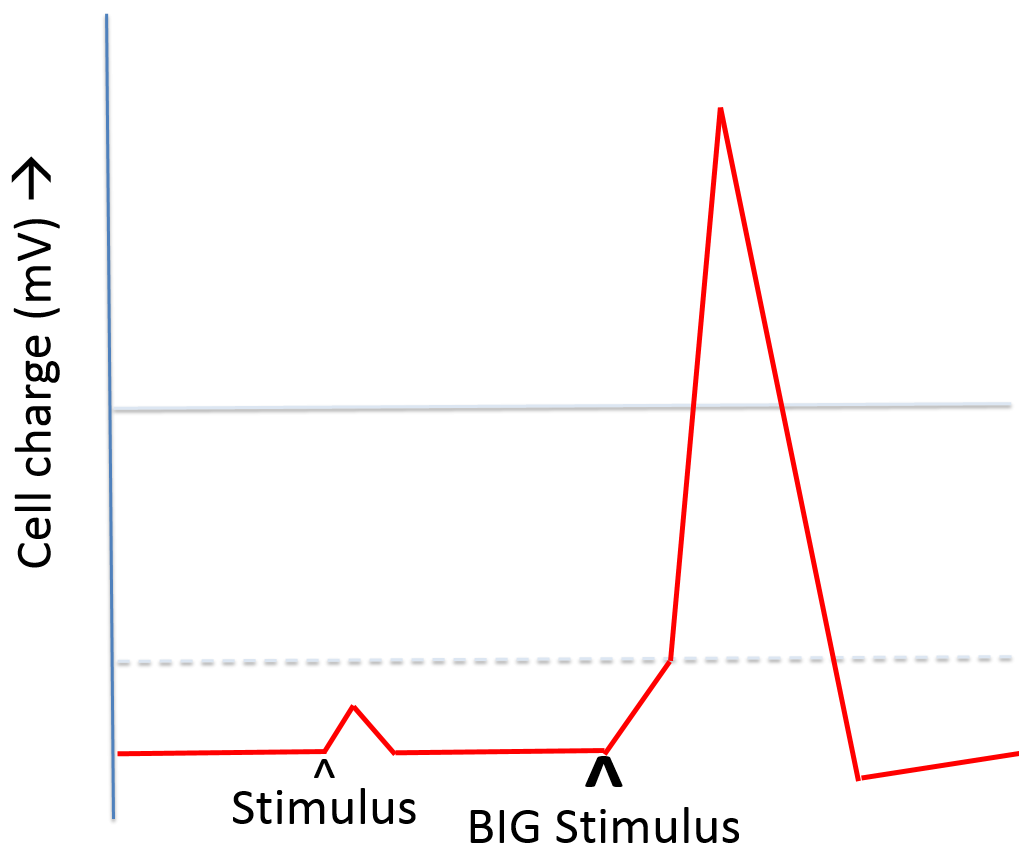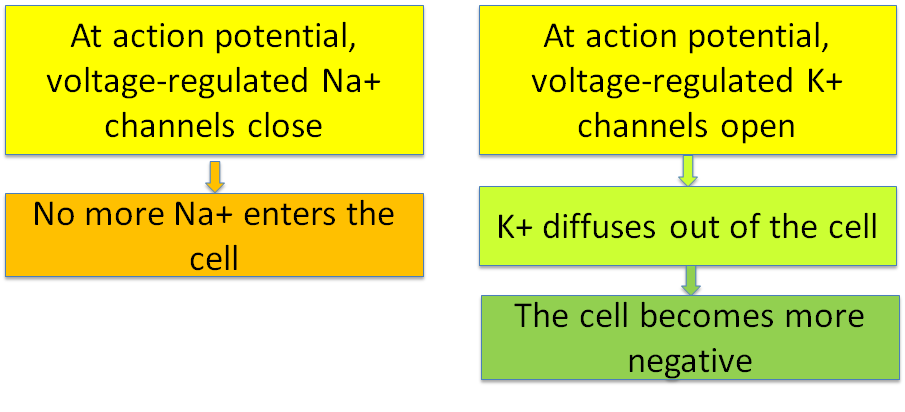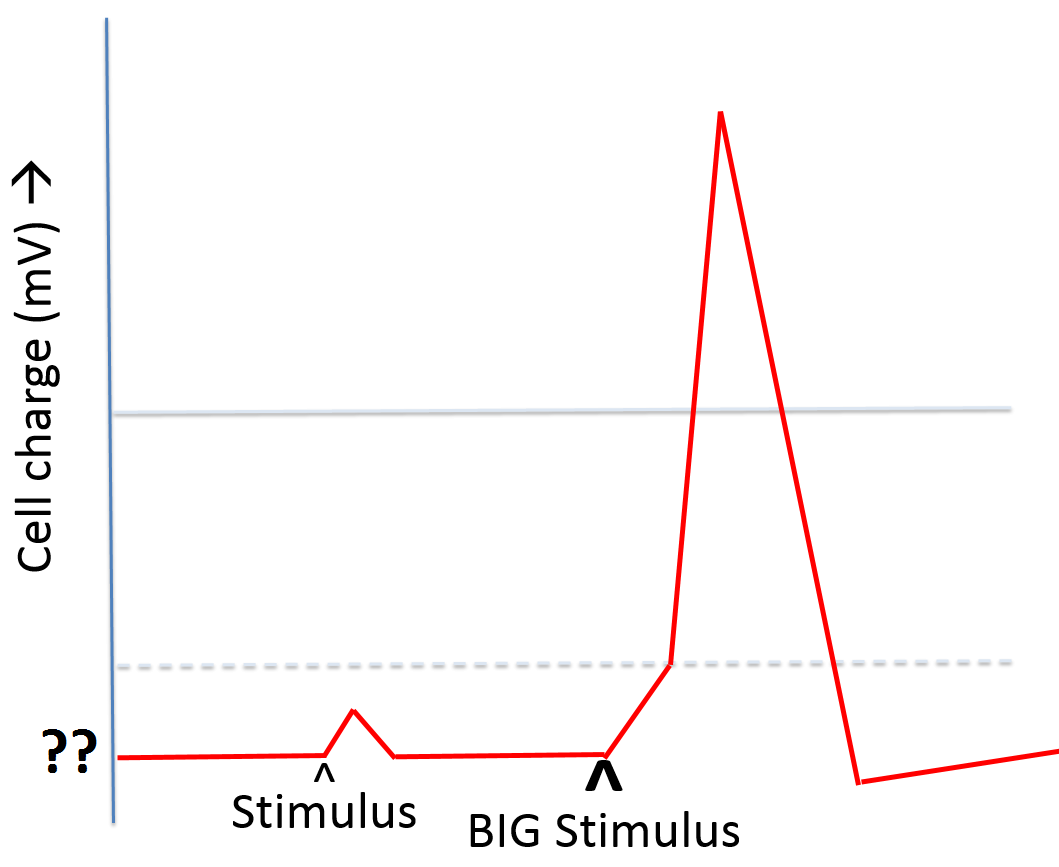This tutorial will take you through the sequence of events in nerve firing.
You can navigate through this tutorial using the buttons at the top of the screen.
The tutorial will ask you questions. Click on your chosen answer to see feedback; click the answer again to make the feedback disappear. When you're finished with one page, click the navigation button for the next page to move ahead.
Have fun! Click on button '1' to see the first page of the tutorial, or you can jump directly to reading the nerve firing graph or constructing a flow chart.
Page 1
Nerve firing is all about cell charge -- electricity.
The first thing to understand is that a cell at rest has a negative charge compared to the blood - mainly because it is full of proteins, which are negatively charged.

This negative charge is called the cell's RESTING POTENTIAL or MEMBRANE POTENTIAL, abbreviated Em. Here's how it would look on a graph:

Take a minute to get oriented to this graph. It has charge down the side - notice that our cell's Em is very negative, far below the zero line.
When that cell actually does something like fire or contract, its charge will become positive for a split second - that's why the horizontal axis of this graph is Time.
Page 2
Let's give this cell a small stimulus - a little shock. Look what happens to its charge -- it gets just a little more positive, and then goes back to normal.

For a cell to become more positive, something with a positive charge has to enter the cell - or something with a negative charge has to leave.

Felix the cat image from Wikipedia Felix the Cat used under a Creative Commons license
Musical note from Pixabay Free Vector Graphics
Page 3
Since the proteins inside the cell are there to do work for the cell, this cell did not become more positive by letting proteins out. Besides, they're too big to pass easily through the cell membrane.The cell became more positive by letting positive ions enter.
Positive ions will enter the cell depending on two factors.
1. The concentration gradient: ions diffuse from areas of high concentration to areas of low concentration.
Here's a picture of the cell and the blood, showing the two major positive ions -- K+ and Na+. Which of them will tend to diffuse INTO the cell?

Page 4
There's more Na+ outside the cell than there is inside, so it will tend to diffuse in.But there's a second factor that controls ion flow.
1. concentration gradient
2. permeability: can the ions get through the membrane?
Ions, being charged, have a hard time getting through the lipid layers of the cell membrane. They enter the cell through proteins instead; these proteins have openings in their centers that let the ion through, so they are called ion channels. They are specific for different ions: only Na+ can go through Na+ channels, only K+ can go through K+ channels.
In this picture the cell is at rest: The red Na+ channels are mostly closed and some of the purple K+ channels are open. Which statement is correct?

Page 5
Here's a better drawing of the cell at rest.
A few of the ion channels are open, letting ions diffuse in and out. And the cell is full of negatively charged proteins, so its internal charge is negative.

Na+ channels are opening, letting Na+ diffuse in
K+ channels are opening, letting Na+ diffuse in
Na+ channels are opening and letting Na+ diffuse out
K+ channels are opening and letting K+ diffuse out
Page 6
Here's what happened: we stimulated the cell, and a few of the Na+ channels opened. Na+ diffused in, and soon the Na+ content of the cell increased. Those additional positive ions inside the cell made its charge more positive.

New term alert!
The Na+ channels that open when a stimulus affects them are called
ligand-gated Na+ channels
A ligand is something that binds to something else. In this case the stimulus is the ligand, and it attached to the channel and made it open.
But it didn't last.
The Na+ channels were only open for a little while, so not very much Na+ got into the cell. And only a few of them opened, anyway. All in all, there was not enough of a change in this cell for you to even notice! This is the sort of thing that happens when a molecule of air hits your skin. Just a little Na+ comes into the stimulated cell, and you don't notice.
Also, see how the charge went right back down? That was because there's an ion pump, the Na+/K+ pump, that moves the Na+ back out of the cell. It got the cell back to its normal state.
Page 7
If we give the cell a BIG stimulus, however, things look quite different.

What do you think made the difference? Both Na+ and K+ channels must have opened
Proteins must have left the cell
The Na+/K+ pump must have stopped
Many more Na+ channels are opening
Page 8
Why did so many Na+ channels open? Was it because the stimulus was stronger?
The stimulus was definitely stronger - but the amount of Na+ entering the cell increased a lot more than the stimulus did. There's something else going on.
Here's the deal: proteins like the ion channels work by changing their shape, to open and close. And proteins are made of long chains of amino acids, with charges on them. You know that opposite charges attract and like charges repel, so it's the charges on those amino acids that determine the shape on the proteins.
The initial stimulus bypassed that system by physically attaching to the ligand-gated Na+ channels and pushing them into a different shape - the open shape. That allowed some Na+ to enter the cell, making it a little more positive.
If enough Na+ entered the cell, and the cell got positive enough, the change in the cell's charge would start to make other proteins change their shapes.
New term alert!
The cell has a second set of Na+ channels, ones that change their shape into the open shape when the cell's charge reaches a certain point. These Na+ channels are called
voltage-gated Na+ channels
and the charge at which they reshape into the open position is called theThreshold potential (Et)
Look at the graph again.

The stimulus opened some ligand-gated Na+ channels, and they let some Na+ into the cell. That made the cell start to become more positive.
Soon, enough Na+ had entered the cell to push its charge up to threshold potential, or Et. At that point, the voltage-gated Na_ channels began to change shape, from the closed position to the open position. There are lots of the voltage-gated Na+ channels, so that allowed lots of Na+ to enter the cell.
Page 9

Once the voltage-gated Na+ channels open, soon there is so much Na+ in the cell that it has entirely lost its negative charge. We say it has depolarized.
Its new charge is called Action potential because this change in the cell's charge causes some action to happen. Maybe the cell will release chemicals, or pass the impulse to another cell it is attached to, or contract. It may pass the message on to your brain, allowing you to detect what's happening.
What's true about this cell?
lots of K+ channels must have opened
Page 10
Right after it lost its charge and depolarized, the cell started to turn negative again. This is called repolarization, because the cell is regaining its charge.

What do you think could have made this happen?
lots of K+ channels must have opened
Na+ must be flowing out of the Na+ channels
The Na+ channels must have closed
What do you think made the channels open or close?
So what kind of channels are these?
Page 11
Now that the cell has repolarized, it only needs to remove the Na+ that diffused into the cell and pick up the K+ that diffused out. The Na+/K+ pump helps with this.
Soon, the cell is ready to fire again! The more often it fires, the bigger a message it will carry to your nerves or muscles. You're done with the introduction to nerve firing. Do you think you remember all of it? If you do, go to the flow chart or the graph reviews using the buttons at the top of the page. Good luck!
flow chart 1
Welcome to the flow chart review. You'll answer questions to build a flow chart of nerve firing. Use the flow chart page buttons above to move through this section of the review. You can go back to introduction or to the graph any time, just by choosing them from the main buttons.
Let's start with our cell at rest.

What is its charge called?
flow chart 2

Good work! The cell at rest is very negative, due to the negatively charged proteins inside it. What else is inside it?
lots of Na+ and very little K+
flow chart 3

Now let's stimulate this cell. What will happen?
ligand-gated K+ channels will open
flow chart 4

The ligand-gated Na+ channels have opened! What will happen as a result?
K+ will diffuse out of the cell
flow chart 5

What will happen to cell charge?
What charge will the cell need to reach before it can start to fire?
flow chart 6

What's so special about threshold potential?
It makes Na+ ions more positive
It changes the shapes of voltage-regulated Na+ channels and makes them open
flow chart 8

What will the cell do now?
The cell will eventually reach:
flow chart 9

What will the voltage-regulated Na+ channels do now?
flow chart 10

What will the voltage-regulated K+ channels do now?
flow chart 11

So what? Who cares?
I care! Because K+ will flow out of the cell!
the cell will just depolarize again (yawn)
yeah, nothing will happen anyway
flow chart 12

What will that do to cell charge?
flow chart 13

The cell got its charge back. What will we call that?
flow chart 14

How will the cell get the K+ back in, and the Na+ out?
flow chart 15
Good work! You've created a flow chart of the events in nerve firing. Here's a copy you can print off:


Now you should be able to use it to solve problems.
Here's the trick of using a flow chart: the arrows mean 'causes'. So if one step on the flow chart doesn't happen, the steps under it won't happen either.
Try using your flow chart to predict what will happen to each of the people below. Then click on them to see if you're right.
Mr. A's ligand-gated Na+ channels are blocked
Mr. B has too many ligand-gated Na+ channels, so even a little stimulus opens lots of them
Mrs. G's voltage-regulated K+ channels stay open way too long
Now you've finished the flow chart! If you want to review the graph, just choose it from the buttons at the top.
graph 1

The question marks are indicating action / resting potential. At this point the nerve cell contains lots of Na+ / K+ and not much Na+ / K+
graph 3

The first stimulus didn't make the cell actually fire, because it wasn't big enough to raise the cell's charge up to this level, the action / threshold potential. This point is really important because it's the charge that will open voltage-regulated Na+ channels / open K+ channels.
The little stimulus DID make the cell get a little positive, though not enough to fire.
graph 2

A stimulus makes a cell more positive because it opens voltage-regulated ion channels / opens ligand-gated ion channels. In this case, those are Na+ / K+ channels.
graph 4

Once the channels are open, Na+ flows into / out of the cell, making its charge more positive. This is called repolarization / depolarization.
graph 5

Now the cell has reached resting / action potential. The Na+ channels will open / close and the K+ channels will close / open
graph 6

Now K+ will flow into / out of the cell, making it more negative again. This is called depolarization / repolarization. After the cell returns to resting potential, it will remove excess Na+ from inside it and replace the K+ that flowed out by using its voltage-regulated ion channels / Na+/K+ pump
Congratulations on finishing the review of the nerve firing graph!
Sources used in creating this tutorial include:
Kuffler,S.W., J. G. Nicholls, and A.R. Martin, 1984. From Neuron to Brain, 2nd ed. Sinauer Associates, Inc., Sunderland, MA
Fox, S. I., 2001. Human Physiology. McGraw-Hill.
Porth, C., 2002. Pathophysiology. 6th Edition. Lippincott, Philadelphia, Pa.
